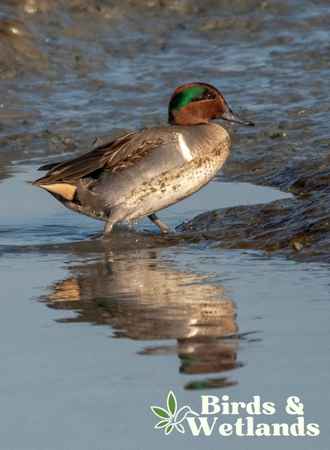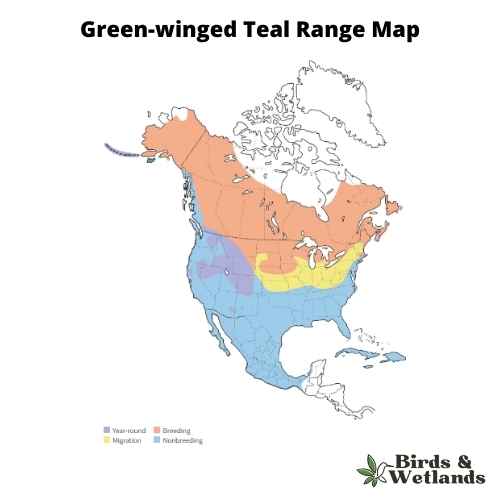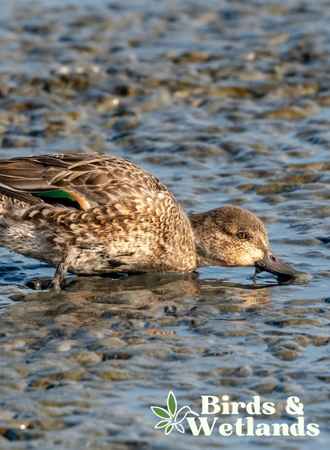The green-winged teal (Anas carolinensis), also known as the common teal, is a small dabbling duck found throughout much of the northern United States and Canada.
It is marked by distinctive green wing patches, making it easily recognizable among other waterfowl. Accompanied by its chocolate-colored head, light grayish body, and green streak behind its eye, it is one of the most beautiful ducks in North America.
Green-winged teals are highly migratory birds that travel far south during winter to escape the cold temperatures of northern climates. They can be found in large flocks year-round and often take on wader-like appearances when in flight.
With such a wide range across continental North America and an exquisite beauty to match, it’s no surprise they remain popular targets for birders and hunters alike.
Scientific Name: Anas carolinensis
Family: Anatidae
Height: 12.2-15.3 in (31-39 cm)
Wingspan: 20.5-23.2 in (52-59 cm)
Weight: 4.9-17.6 oz (140-500 g)
Green-Winged Teal Description
Like most ducks, green-winged teals exhibit sexual dimorphism.
The adult male green-winged teal is a small duck with a chestnut head and white stripe down its side. It has a distinct green streak behind its eye, as well as dark gray to black bill and dark brown eyes.
Its legs and webbed feet are black, and the wings have a beautiful green speculum or patch. The upper parts of the body have grey feathers slightly washed in brown, with narrow vermiculations or streaks.
The adult female green-winged teal is a striking bird with distinct physical features that separate it from the male of the species. It has a light brown head, neck and throat, while its upper body is a mottled brown with pale brown markings throughout. Its underparts are white, and it has a cream-colored stripe at the rear.
What truly sets it apart is its distinctive wing speculum, an emerald green color far more vivid than the males. This vibrant hue stands out against its darker feathers, making this spectacular bird easily recognizable in any setting.

Listen to Green-Winged Teal
The females quack while the males whistle.
Green-Winged Teal Habitat & Range
Green-winged teals breed with other species of ducks in many parts of North America, from the far north near the Aleutian Islands and northern Alaska and Canada down to more southern areas such as central California, Nebraska, Kansas, Minnesota, Wisconsin, and the Maritime Provinces.
These dabbling ducks inhabit many habitats but are more abundant in tidal marshes, shallow wetlands and northern boreal forests. They prefer shallow water with emergent and floating vegetation like bulrushes and sedges or flat open areas with plenty of grassy covers.
Fall migration begins in late August to early December. During their winter migration, these ducks can be found along the entire Pacific Coast of North America and in Mexico and other parts of Central America. They even travel farther south to northern South America.
These birds typically inhabit coastal wetlands, freshwater marshes, coastal marshes, flooded fields and other shallow bodies of freshwater similar to those from which they originated. These areas are usually packed with dense vegetation like reeds or cattails that provide shelter from predators.

Green-Winged Teal Diet & Food Habits
The green-winged teal is a small duck that primarily feeds on plant matter found in the water’s surface. They prefer mud flats but will also visit shallow marshes and temporarily flooded agricultural lands. They will dip their bill into the water and filter through the mud for small animal matter.
The green-winged teal dabbles to reach submerged aquatic vegetation. Their varied diet includes aquatic and emergent vegetation seeds, stems, aquatic insects, small fish and fish eggs.

Green-Winged Teal Nesting & Mating Habits
The green-winged teal is a unique duck species, as it is one of the earliest waterfowl to breed in the spring. Their spring migration begins early and their breeding season commences in late April to early June when the temperature and weather conditions are more favorable to them.
During this time, the female starts building a nest, which is a shallow depression on the ground, made of grass and lined with down for warmth. The nest is usually placed in tall grass or dense vegetation and often near water, such as small shallow permanent ponds.
The female lays 6-10 creamy eggs and incubates them for 23 days before hatching. The male leaves the nesting area and does not take part in nesting duties, nor does he care for the chicks, leaving that task to the female, who keeps them warm against cold weather with her downy feathers.
Soon after hatching, the female leads them to food sources. She performs distracting displays to let her and her young escape predators. The young fledge at about 30 to 35 days.

Green-Winged Teal Population & Conservation Status
The current population and conservation status of the Green-winged Teal are generally good. Its global breeding population has been estimated at 6.7 million, resulting in a low conservation concern for this species.
Most of the breeding grounds for this species lie in Canada and Alaska, in areas that are largely remote and protected from development that could otherwise affect their numbers.

Green-Winged Teal Hunting
Green-winged teals are the second most commonly hunted duck species in the US. Every state has slightly different regulations regarding bag limits and other rules. However, they are generally structured around population size estimates and harvest objectives to help sustain these North American birds.
Key Points
- The green-winged teal feed on plant material but will occasionally eat small animals.
- Females lay between six to ten eggs.
- The green-winged teal is the smallest dabbling duck in North America.

